Rugs would not only give more characters to a room, but they also provide a soft, comfortable surface for your feet. Rugs serve a variety of purposes in a room. It can be used as a seating area while hosting an event with a large number of people, and also provide a beautiful and soft surface under your feet as you sit on the sofa. If you have children, rugs can be used as a safe and comfortable play space. If your living room has an open floor plan, rugs can be used as a room divider as well as a way to designate the seating area.
There are numerous elements to consider, including size, material, style, —and having a seemingly unlimited range of options doesn’t make the task any easier. To make things easier for you, we are here to share a few tips you need to know before choosing a rug for your living space.
Rug Size
You should consider the size and shape of your room, as well as the location of your furniture and your interior decor. It’s critical that the rug you choose is proportionate to the space and does not throw off the balance. The space in your home should be enhanced by a decent rug.
There is a rug for every situation, whether you have a little room that you want to make appear larger or a large space that you want to break up, there is a rug style and size perfect for every room.
From the sizes, Rugs can be divided to a small rugs, medium rugs, and large rugs:
- Small Rug – A small rug in the middle of the room with a central coffee table is ideal for small living room spaces because it creates a focal point and makes the area feel larger. Ascertain that the rug size is proportionate to the floor area between the furniture.
- Medium Rug – The front legs of seated furniture on the rug is a frequent rug placement choice for the living room. This is a wonderful alternative if you don’t want a full-room rug because it will cover the floor space in front of the furniture, which is the most visible region. It’s best if the furniture is against the wall so that the rug isn’t completely covered. Medium Rug also works for Bedroom. Bed partly on rug Another way to add symmetry to a room is to place the bed partly on a medium rug – around 2/3 on is a good ratio. This rug placement can help the room feel put-together and add character, without filling the entire space.
- Large Rug – For the living room, the best rug placement choice is to put all of the furniture on the rug. This is a great option for open-plan areas because a huge rug with all of the furniture helps to define the space. It’s critical to provide adequate space around the perimeter of the furniture to avoid it being perched on the rug’s edge, which can make the rug appear too small for the space. You can also place a large rug for your bedroom. Using a wide rug to cover the entire bed is a terrific way to designate the sleeping area in a room. This arrangement should incorporate both bedside tables and any other furniture that surrounds the bed. The furniture on the opposite walls, on the other hand, does not need to be included into the rug, and the main bedroom passage should not be covered.
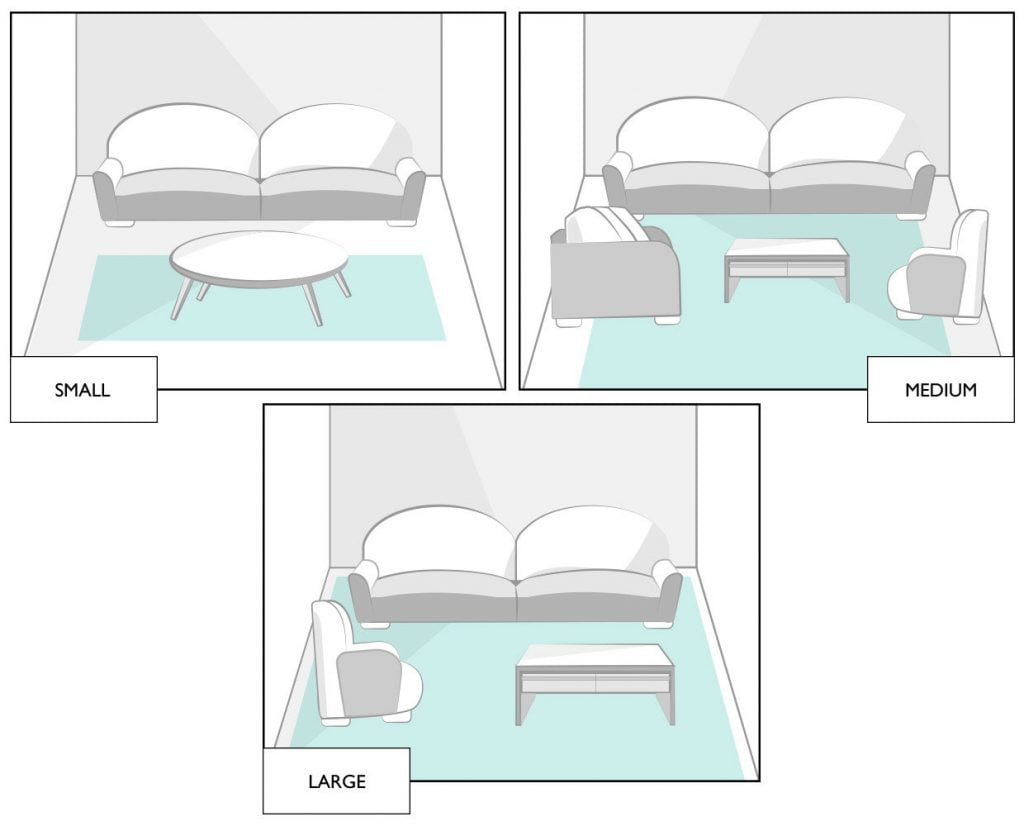
Other than the size of the rugs, there are types of shapes of Rug you might need to know:
- Rectangular Rug – Rectangular rug is work rectangular dining tables. This solution works in any room size, and the appropriate rug size is determined by the room’s and dining table’s measurements. If you have a rectangular table, a rectangular rug is the way to go. Make sure the rug is large enough for all of the chairs to stay on it when they are brought out – if chairs slip off the rug’s edge, the space will feel smaller and unbalanced. For rectangle rugs the size varies from Small (S) to Extra Large (XL) the sizes for that are:
Small (S): L160 cm x W100 cm up to L230 cm x W160 cm,
Medium (M): L 200 cm x W140 cm up to L290 cm x W200 cm,
Large (L): L280 cm x W190 cm up to L330 cm x W240 cm and
Extra Large (XL): W300 cm x L400 cm
- Round Rug – In general, the same criteria apply to round rugs as they do to rectangular carpets for limited spaces/round dining tables. A circle rug should always be paired with a round dining table, and the size you require will be determined by the room’s and table’s proportions. If you don’t have a lot of room, a round table is a fantastic choice, and a round rug will complete the look. Once again, ensure the rug is big enough so all chairs remain on it when they are pulled out. For round rugs the size varies from Small (S) to Large (L) the sizes for that are Small (S): diameter 160cm, Medium (M): diameter 200cm, Large (L): diameter 240cm
- Runner Rug – A runner rug next to the bar area is a terrific way to liven up the space and give it a more contemporary feel. To add personality, choose a colorful and patterned rug that is no longer than the length of the bar area. This is a terrific method to separate the kitchen from the dining room or to create a vibrant environment in modern open-plan areas.
A runner rug can also be used in the bedroom. A runner rug can be placed on each side of the bed. If you have space on both sides of your bed, a matching runner rug on either side is a terrific way to add harmony and color to the room. Make sure the runner is broader than your bedside table and the same length as the bed; if it is longer, the room will feel uneven.
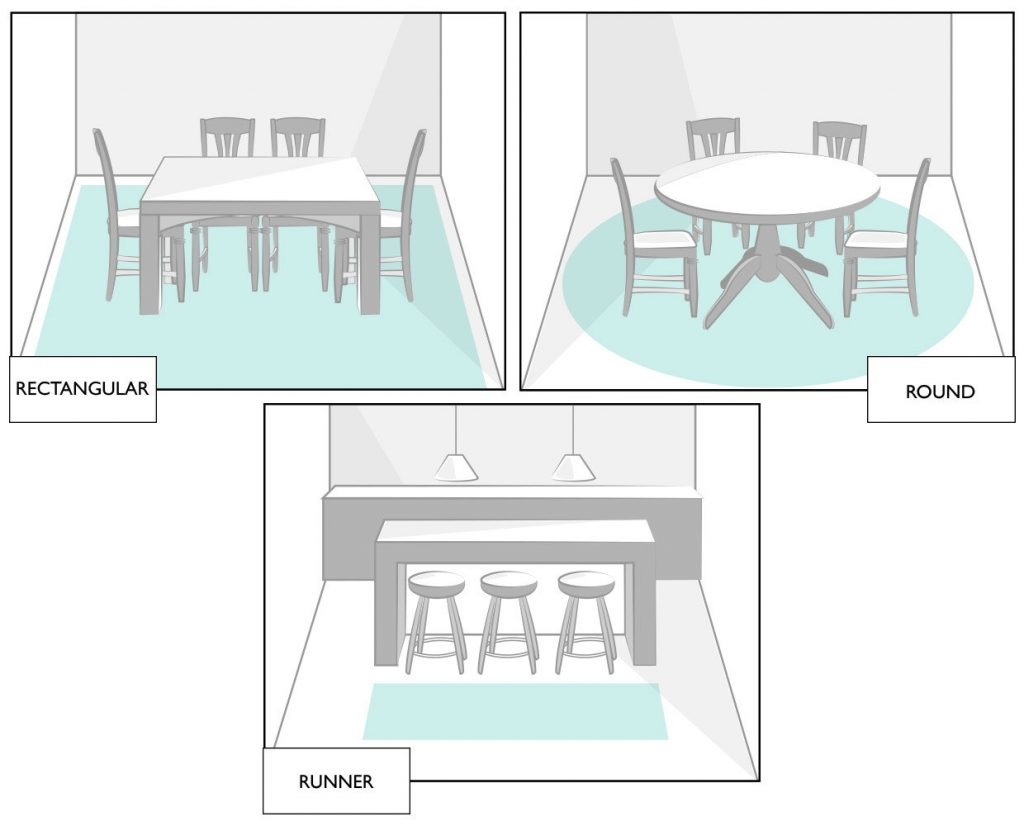
You want a rug that is appropriate for your space, whether small or large, or whether it is round or rectangular. Experts suggested something that isn’t too big—there should be enough floor visible between the wall and the rug—but also not too small, like a postage stamp under your coffee table. Find a rug that can contain the key parts of a room or act as a buffer between built-ins as a general guideline.
Rug Material
Quoted from apartmenttherapy.com, Rug specialist Lisa Wagner, of RugChick.com, says these are the most common material categories:
Natural fibers: Wool, cotton, silk, jute, sisal
Pros: Durable and long-lasting; wool rugs, specifically, are amazing at hiding soil.
Cons: Often pricier and require professional cleaning; dyed silk rugs can run if exposed to water spills.
Synthetic fibers: Acrylic, polyester, polypropylene
Pros: Affordable, easy to clean, usually stain-resistant.
Cons: May need replacing sooner than wool or natural fiber rugs.
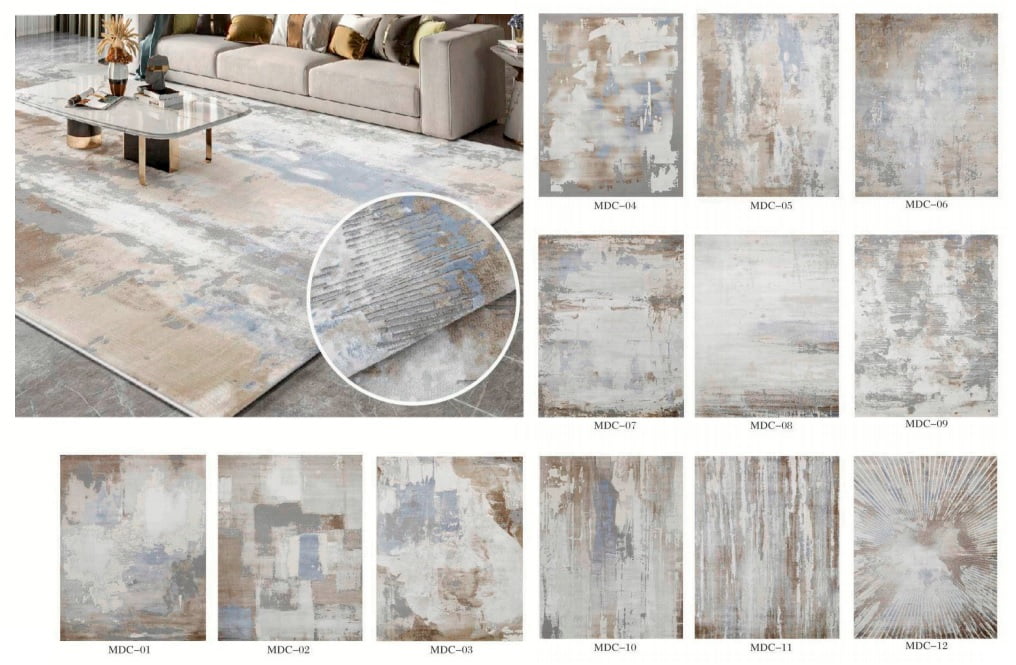
Artificial silk: Viscose, bamboo silk, banana silk
Pros: Very affordable; busy patterns can conceal dirt.
Cons: Viscose is like an absorbent sponge—it not only attracts moisture and oil but even a plain water spill can ruin fibers.
Think about the material. Choose a soft rug to step on, to sit on, or to children’s play area. Depending on your choices and demands, you can also choose a high pile or low pile rug.
Low-pile rugs: These rugs have shorter fibers and loops (think flatweaves), making them best for high-traffic areas such as the kitchen.
High-pile rugs: These rugs have taller, looser fibers (think shag or Moroccan rugs), making them more plush and ideal for the bedroom or living room.
The height of a rug’s pile is really more of an aesthetic and performance consideration. Regardless of the pile height, a rug will always provide sound buffering, but the thicker the rug, the better the insulation. Added pile also increases the life and performance of the carpet over time.
Patterned or Plain Rug
A boldly patterned rug can be the defining feature of a living area, but it’s a choice that requires courage, because it has such a big impact. Deciding whether to go with a graphic statement rug or something more understated comes down to personal preference, as well as your overall design vision and where your home is.
Polypropylene & Polyester Pattern Rugs – Belle Premium Rugs, Theory of Living
Keep in mind also that a patterned rug will be better for hiding dirt and spills while a solid rug is more likely to show stains. If you have a colorful room and still want a colorful rug, look for something that will tie the colors together. The goal is to keep them from fighting; otherwise, you’ll end up with a visually congested environment.
Remember that the flooring you choose has a significant impact on the entire design of the room, so pick something you’ll enjoy for a long time. Whatever you choose, make sure the rug you chose complements the rest of the room. A rug with vivid patterns and colors might make a difference in your living room if it needs a little festive décor.
Rug Care and Cleaning
It’s inevitable that, at some point, you’ll find yourself with a soiled rug, so you’ll want to think about care and maintenance before you buy.
Here’s how to care for and clean different materials:
Synthetics: Spot-clean, steam-clean, or vacuum. They may appear dirtier since they absorb dirt and oil, though most (such as acrylics and polypropylene) will be stain-resistant.
Wool: Natural oils (lanolin) keep spills from penetrating the fibers, notes Revival Rugs’ Hyman. “For hand-knotted rugs, you can blot the stain to soak up any excess, then use a toothbrush with dish soap and water to tease it out. Resist the urge to scrub, which can damage the fibers.”
Cotton and silk: Enlist the help of a professional to prevent making stains worse by trapping them deeper within the fibers.
Those are some tips on how to choose a rug for your home. Hopefully it’s useful and will help you to make your home even more beautiful and comfortable.
If you are interested and looking for a rug that is suitable for your room, Theory of Living is here to help you by providing a variety of Rugs to beautify your room. Check Theory of Living for more of our products
Source: apartmenttherapy.com, nytimes.com, thespruce.com, ikea.co.id, amara.com
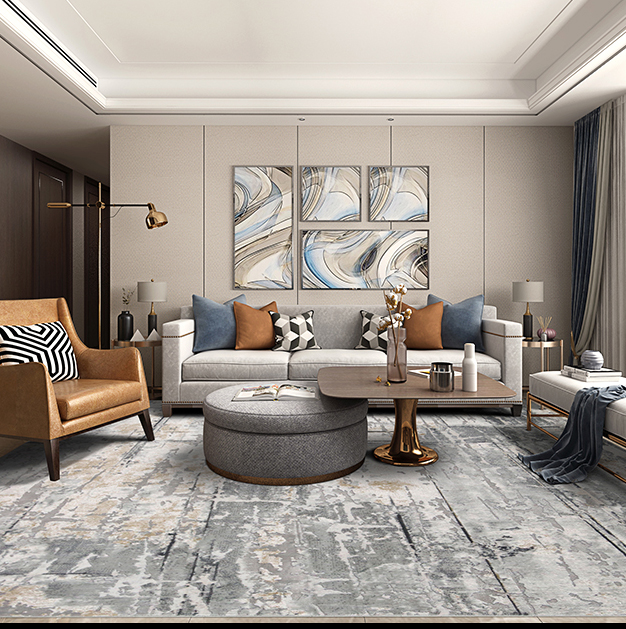
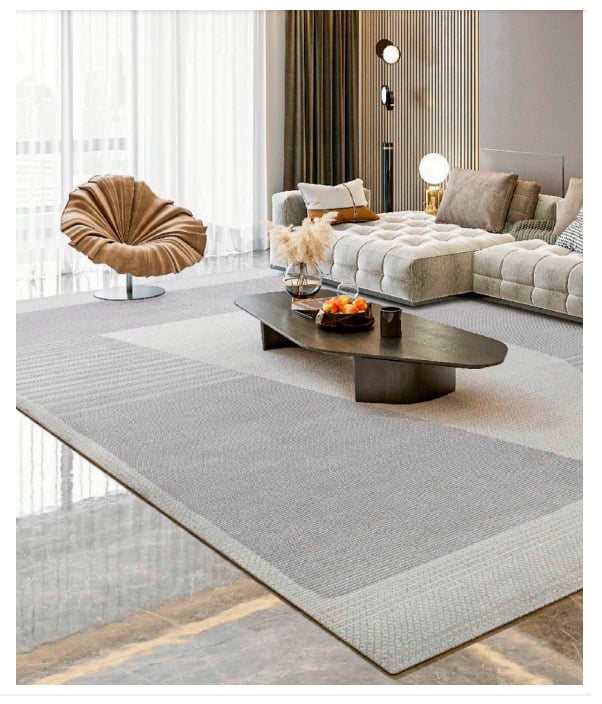
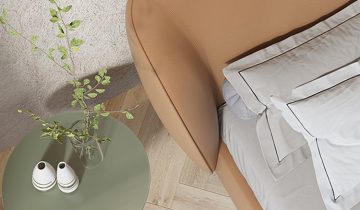
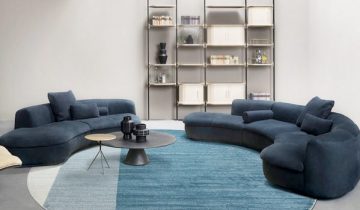
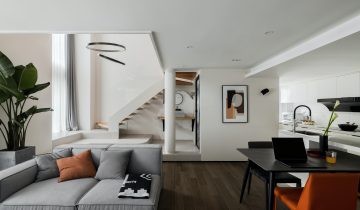
 No products in the cart.
No products in the cart.